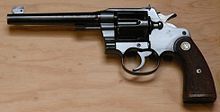Colt New Service
| Colt New Service revolver | |
|---|---|

Colt New Service
|
|
| Type | Revolver |
| Place of origin | United States |
| Service history | |
| In service | 1898–1946 |
| Used by |
United States United Kingdom Canada Commonwealth of the Philippines Royal Canadian Mounted Police |
| Wars | Spanish–American War, Boxer Rebellion, Second Boer War, World War I, World War II, Korean War, Vietnam War (limited) |
| Production history | |
| Manufacturer | Colt's Patent Firearms Manufacturing Co. |
| Produced | 1898–1946 |
| No. built | 356,000+ |
| Specifications | |
| Cartridge | .45 Colt, .455 Webley, .476 Enfield, .45 ACP, .44-40, .44 Special, .38-40, .38 Special, .357 Magnum |
| Action | double-action revolver |
| Feed system | 6-round cylinder |
| Sights | fixed blade front, notch rear |
The Colt New Service is a double-action revolver made by Colt from 1898 until 1941. It was adopted by the U.S. Armed Forces in caliber 45 Revolver Model of 1909 as the Model 1909 U.S. Army, Marine Corps Model 1909, Model 1909 U.S. Navy and in .45 ACP as the Model 1917 U.S. Army. The Model 1917 was created to supplement insufficient stocks of M1911 pistols during World War I.
The Colt New Service was the largest revolver ever manufactured by Colt and one of the largest production revolvers of all time until the 1970s. There are several generational variants including the "Old Model" (which refers to the first 21000 units made),"Transitional Model" (which incorporated a hammer-block safety), "Improved Model" (325,000 units) and "Late Model" (manufactured from 1928 to 1941). A "Target Model", "Shooting Master" and "Deluxe Target Model" were offered as well.
Colt had produced a revolver for the U.S. Army called the M1909, a version of their heavy-frame, .45-caliber, New Service model in .45 M1909, a version of the .45 Long Colt with an enlarged rim to facilitate extraction, to supplement and replace a range of 1890s-era .38 caliber Colt and Smith & Wesson revolvers that had demonstrated inadequate stopping power during the Philippine–American War. The Colt M1917 Revolver was a New Service with a cylinder bored to take the .45 ACP cartridge and the half-moon clips to hold the rimless cartridges in position. Later production Colt M1917 revolvers had headspacing machined into the cylinder chambers, just as the Smith & Wesson M1917 revolvers had from the start. Newer Colt production could be fired without the half-moon clips, but the empty cartridge cases had to be ejected with a device such as a cleaning rod or pencil, as the cylinder extractor and ejector would pass over the rims of the rimless cartridges. During its lifetime, the Colt New Service was the most popular revolver made by Colt, surpassing 150,000 units. After World War I, the revolver gained a strong following among civilian shooters.
John Henry Fitzgerald was an employee of Colt prior to World War II and was known to carry of a pair of New Service "Fitz Specials" in his front pockets. These revolvers had bobbed hammers, 2" barrels, shortened and rounded grip frames, and the front of the trigger guard was removed. Although less than 30 left the factory, it became an after-market conversion for many gunsmiths. Colonels Rex Applegate and Charles Askins were proponents of this model.
...
Wikipedia
